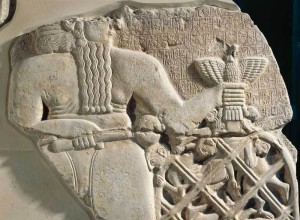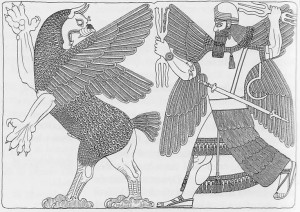WHO IS NINURTA
Ninurta is the god of thunderstorm and floods in the spring. He is the son of God Enlil, he is presented in the text as “storm of Enlil”. Ninurta is especially the god of farmers (being linked to spring time), those in the north, in Nippur, and in the east, in Girsu. His name means “lord of the plough” formed by Nin.ḫurta. He makes the soft ground in the spring and then arable. Since 2250 BC, that is, during the reign of Gudea, Lagash to attest to the presence of a god Nin.Girsu “Lord of Girsu”. This city is located about 25 km north-west of Lagash and was the religious center of this metropolis. Ningirsu has the same prerogatives of Ninurta and probably is his personification. In fact in the cylinder of Gudea Ningirsu is identified as a “deluge of Enlil, Ninurta epithet.
ICONOGRAPHY
In the myth Ninurta is imagined as a flying bird with open wings in the sky and he presents a lion’s hea that with his roar causes thunder, known as Imdugud “heavy rain”. In the region of Diyala in the second Early Dynastic , Imdugud is often represented in the seals, sometimes half humanized (in the lower part of the body) other times altogether with an emblem in the form of a bird on the base. In the stele of Eannatum Ningirsu (third Early dynastic) the god Ningirsu is represented humanized with Imdugud in his hand. While the complete humanization of this god happens with Ashurbanipal, who adorned his temple with Ninurta in human form complete with wings.
GOD WARRIOR
In the representations and mythology Ninurta figure as the leader in battle, defense against enemies (so the stele Eannatum against Umma). According to mythology Imdugud became the enemy of the god Ninurta humanized who defeated him in battle mountain capturing and tying him to his cart. Also like any deity linked to rain he is depicted as a warrior god whose roar is reminiscent of the thunder storm that across the sky with a war chariot.
CHI È NINURTA
Ninurta è il dio del temporale e delle inondazioni della primavera. Egli è figlio del Dio Enlil, infatti nei testi viene presentato come “tempesta di Enlil”. Ninurta è soprattutto il dio dei contadini (essendo legato ai temporali primaverili), quelli del nord, in Nippur; e ad est, in Girsu. Il suo nome significa “signore dell’aratro” formato da Nin.ḫurta. Egli in primavera rende la terra morbida e dunque arabile. A partire dal 2250 a.c., cioè durante il regno di Gudea, a Lagash è attestata la presenza di un dio Nin.Girsu “Signore di Girsu”. Questa città è situata circa 25 km a nord-ovest di Lagash ed era il centro religioso di questa metropoli. Ningirsu presenta le stesse prerogative di Ninurta e probabilmente è la sua personificazione. Infatti nel Cilindro A di Gudea Ningirsu viene identificato come “diluvio di Enlil, epiteto di Ninurta.
ICONOGRAFIA
Nel mito Ninurta è immaginato come un uccello che vola con le ali aperte nel cielo e presenta una testa di leone che con il suo ruggito provoca il tuono, noto come Imdugud “pioggia pesante”. Nella regione del Diyala nel Protodinastico II, Imdugud è spesso rappresentato nei sigilli, talvolta metà umanizzato (nella parte inferiore del corpo) altre volte completamente con un emblema sotto forma di uccello sulla base. Nella stele di Eannatum Ningirsu ( Protodinastico III) il dio Ningirsu viene rappresentato umanizzato con Imdugud nella sua mano. Mentre l’umanizzazione completa di questo dio avviene con Assurbanipal, che adorna il suo tempio con Ninurta sotto forma umana completo di ali.
DIO GUERRIERO
Nelle rappresentazioni e nella mitologia Ninurta figura come il leader in battaglia, difensore contro i nemici (cosi nella stele di Eannatum contro Umma). Secondo la mitologia Imdugud divenne il nemico del dio Ninurta umanizzato che lo sconfisse in battaglia sulle montagne catturandolo e legandolo al proprio carro. Inoltre come ogni divinità legata alla pioggia egli è rappresentato come un dio guerriero il cui ruggito ricorda il tuono della tempesta che attraversa il cielo con un carro da guerra.


